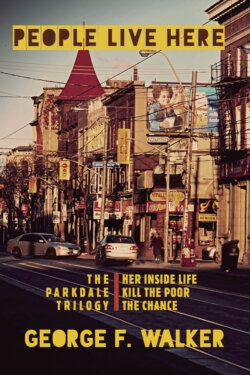Читать книгу People Live Here - George F. Walker - Страница 5
На сайте Литреса книга снята с продажи.
FOREWORD
Оглавлениеby Wes Berger
When I was growing up I fantasized about being in theatre, but there wasn’t much around me that made it seem like that could happen. In Chippawa, a working-class part of Niagara Falls, Ontario, young people were more inclined to go to bush parties or creekside bonfires for recreation or, if you were lucky enough to have a car, to cruise up and down Clifton Hill, the hub of the tourist area of the city. Somehow I found my way to Brock University in St. Catharines and took some theatre courses, but my connection to theatre still felt tenuous. It was only when I was introduced to George F. Walker’s plays that the hook landed good and deep. His characters talked like my uncles, and their determination to be seen, heard, and understood, their resilience in the face of seemingly impossible circumstances, inspired me. Their concerns – poverty, family, survival, rules and laws that seemed indifferent or even hostile to people’s well-being – were ones I had seen in my own life and in the lives of the people around me. For the first time, the theatre felt like a place where I might really belong.
When I was invited to write the preface for People Live Here, I asked myself what the three plays in Walker’s Parkdale Trilogy have in common, apart from being set in the same low-income apartment complex. On some level, all three plays are populist fantasies of belonging and justice, grounded by the great empathy Walker feels for his characters and expresses through them, and tempered by their genuinely deep grief and pain.
Because Walker writes about working-class characters, his plays are sometimes miscategorized, and thus misjudged, as “social realism.” The protagonists in this collection are all women who are marginalized by their life circumstances:
Marcie in The Chance by her poverty, depression, and age; Lacey in Kill the Poor by her poverty, history of addiction, and sex work; Violet in Her Inside Life by her mental illness and violent history. Is it likely that any of these women would end up with the almost-happy endings that these stories provide them? Probably not. But does that matter? Walker takes care to honestly depict these women’s socio-political conditions, and to overtly critique the power structures behind them; but what really lies at the strongly beating heart of these plays is a stirring mix of the representative and the mythic.
Part of the power of these often darkly hilarious, touching, and sometime-harrowing plays is that the playwright envisions a different kind of ending for his characters. These grieving, angry, beleaguered women endure so much, but they also fight back with huge reserves of toughness, intelligence, courage, and grit. They are genuine, layered, complex characters, and they are also inspirational folk heroes. In these works, Walker not only moves people who would normally be on the margins to centre stage, he gives them a fighting chance at winning. I love them all so much, I want to believe they might.
